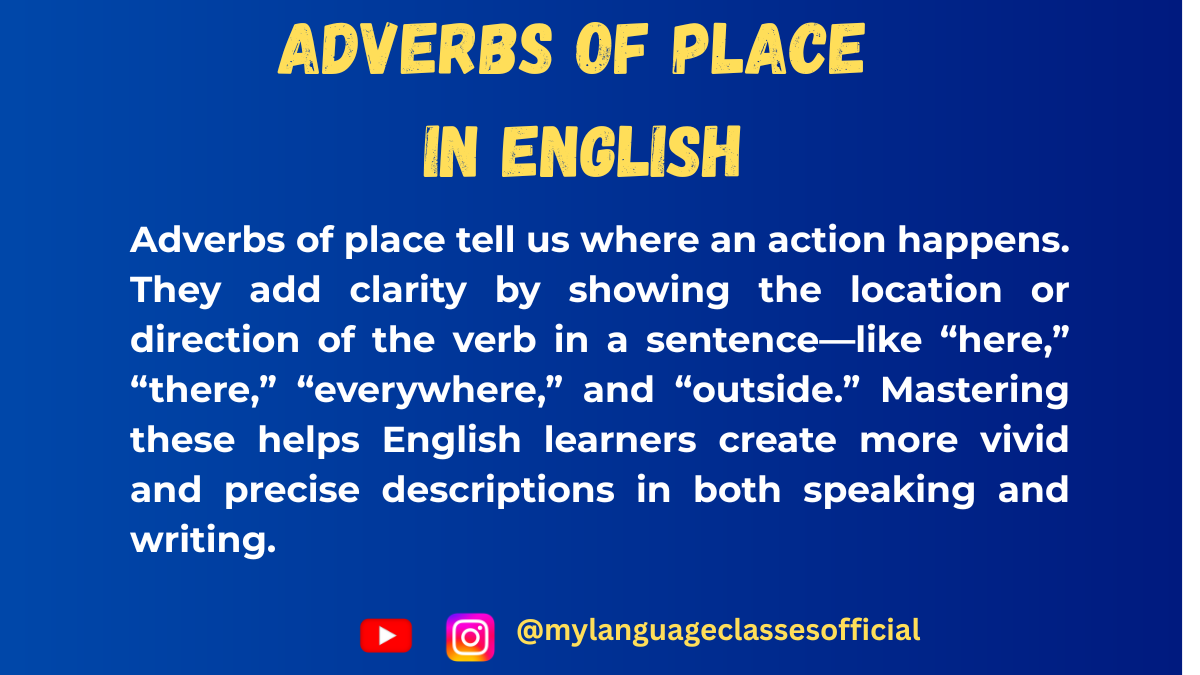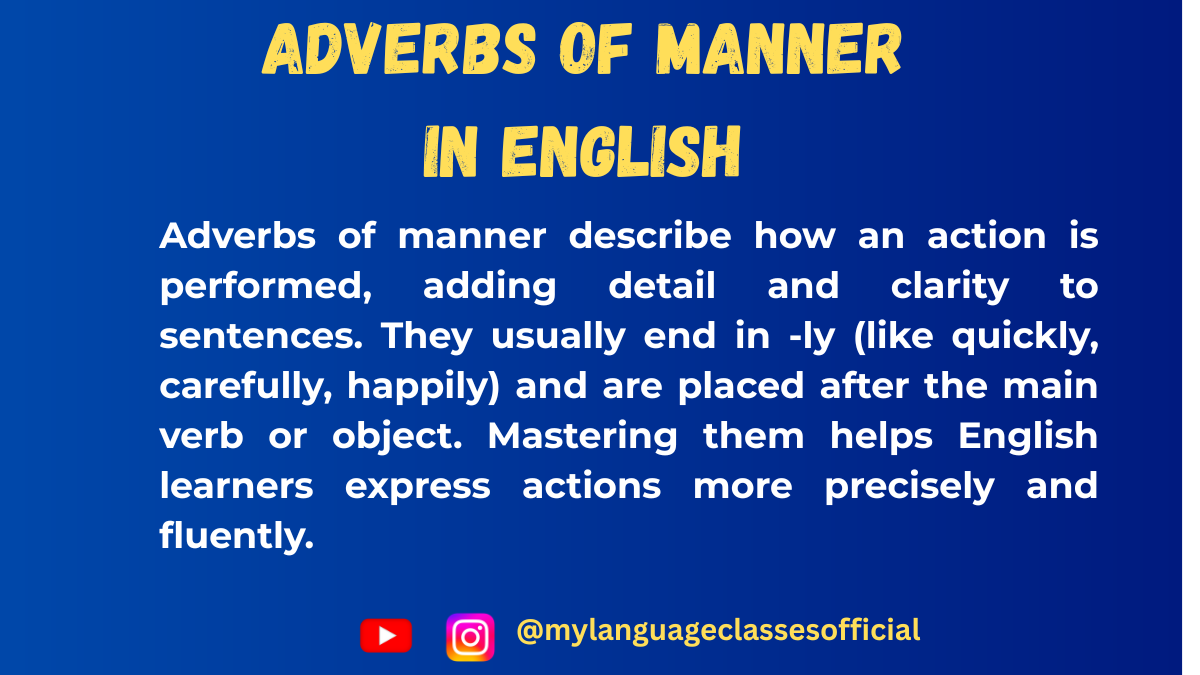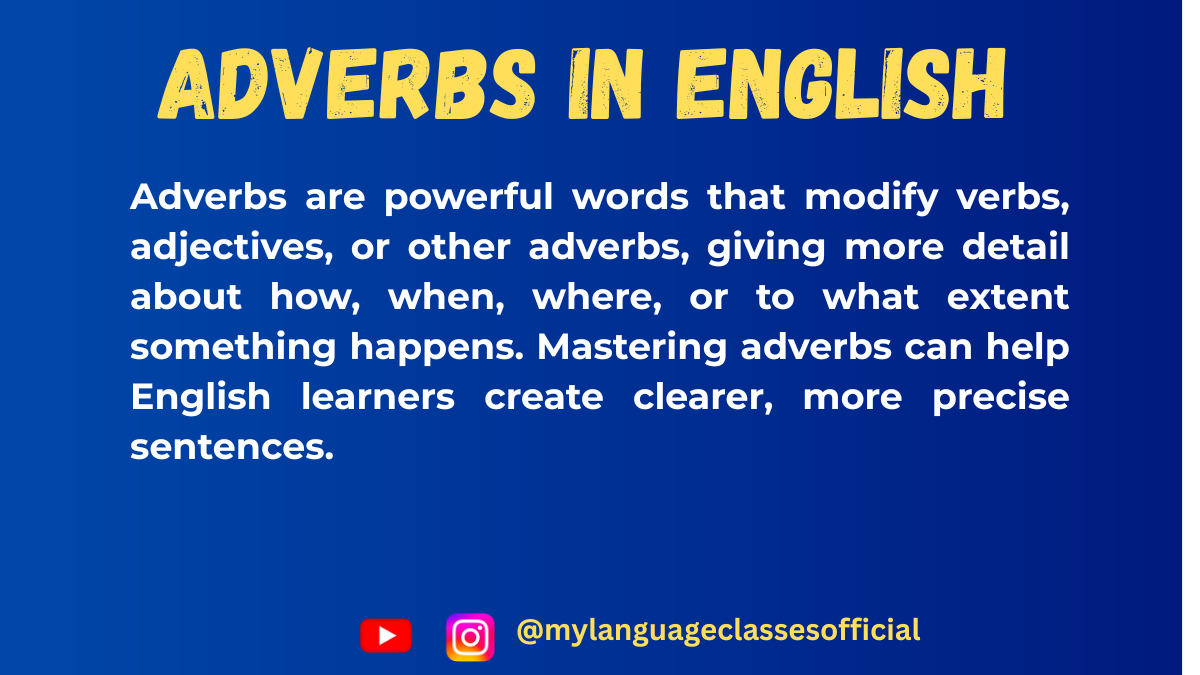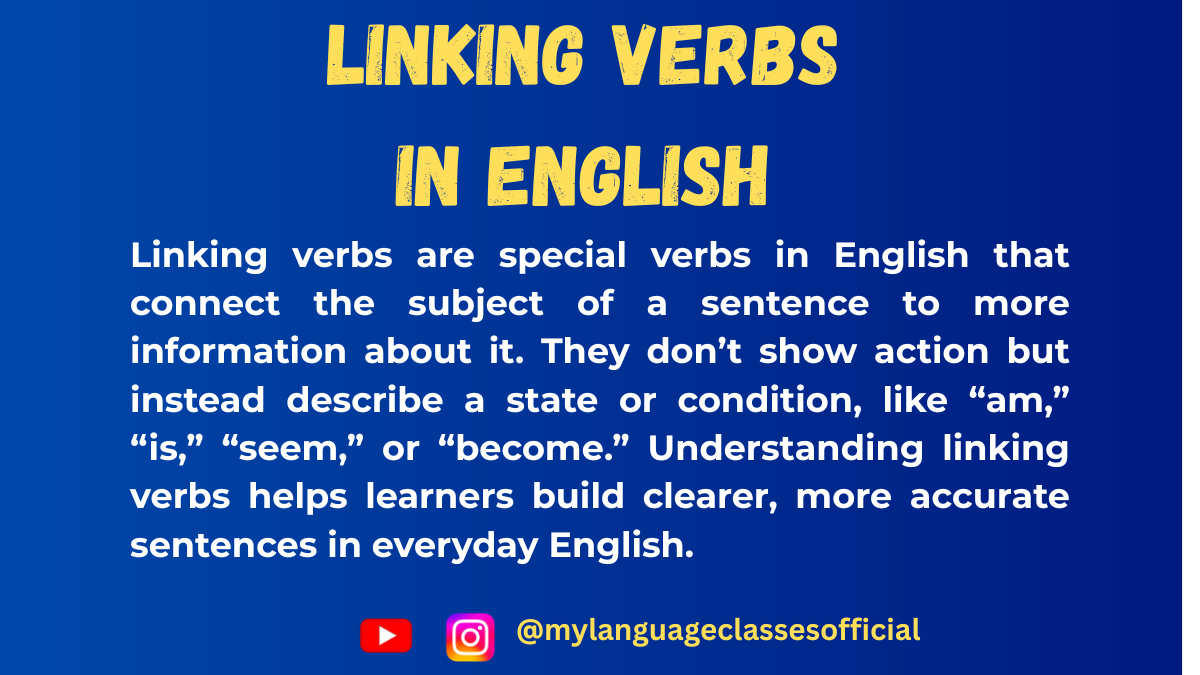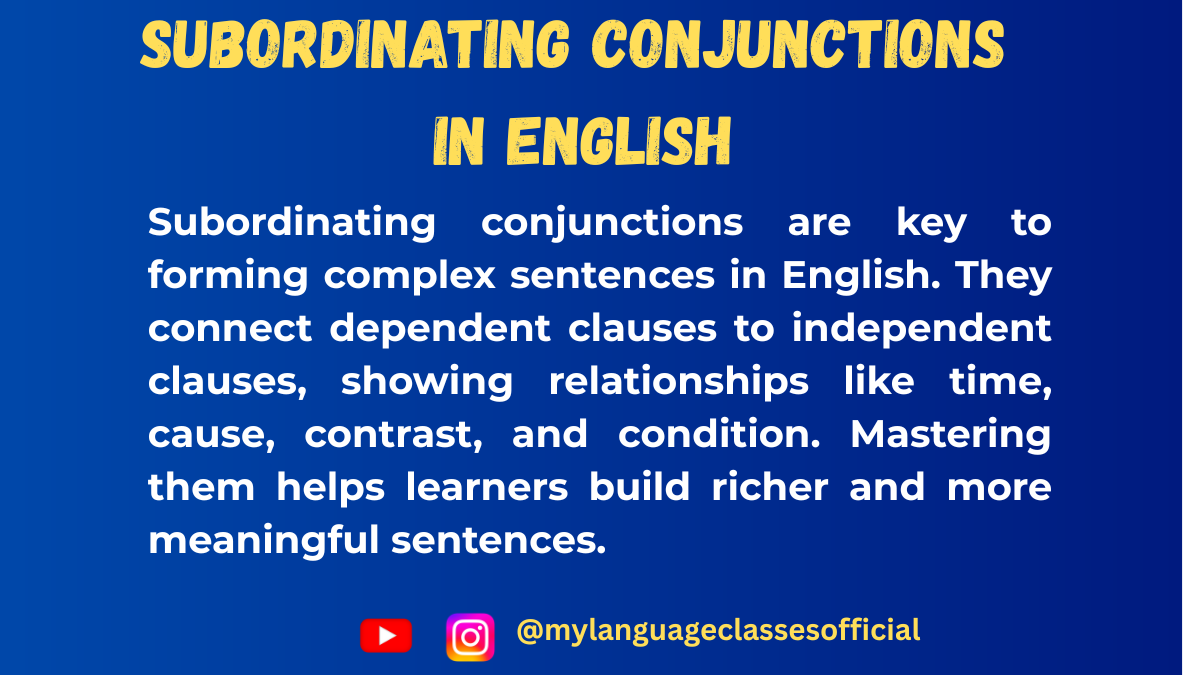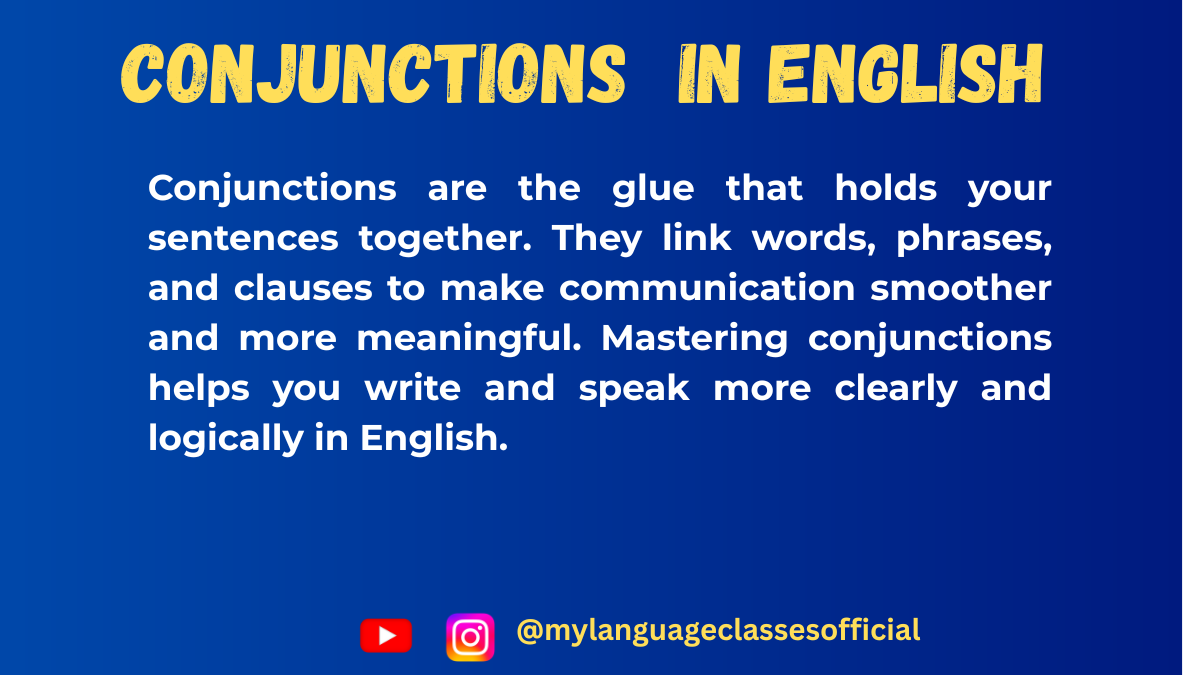Your cart is currently empty!
Tag: Advanced English Vocabulary
-

Adverbs of Frequency in English: Usage, Rules, and Examples
Adverbs of frequency are an essential part of English grammar, helping us express how often an action occurs. They answer the question “How often?” and provide clarity in both spoken and written communication. Whether you’re a beginner or an advanced learner, mastering these adverbs will enhance your fluency and precision in English.
In this blog post, we will explore common adverbs of frequency, their usage, grammar rules, and key points to remember. We will also include examples, exercises, and answers to solidify your understanding.
Common Expressions
Here are some of the most commonly used adverbs of frequency, listed from most frequent to least frequent:
- Always (100%) – “She always wakes up early.”
- Usually (90%) – “He usually drinks coffee in the morning.”
- Frequently (80%) – “They frequently visit their grandparents.”
- Often (70%) – “I often go to the gym after work.”
- Sometimes (50%) – “She sometimes forgets her keys.”
- Occasionally (30%) – “He occasionally eats junk food.”
- Seldom (20%) – “They seldom watch television.”
- Rarely (10%) – “I rarely go to the beach.”
- Hardly ever (5%) – “She hardly ever drinks soda.”
- Never (0%) – “He never smokes.”
Usage of Adverbs of Frequency
Adverbs of frequency are used in various situations:
- To describe habitual actions:
- “I always brush my teeth before bed.”
- To talk about general truths:
- “The sun always rises in the east.”
- To describe routines and habits:
- “She often goes jogging in the park.”
- To express the likelihood of events:
- “He rarely forgets his homework.”
Grammar Rules for Adverbs of Frequency
To use adverbs of frequency correctly, follow these rules:
1. Placement in a Sentence
- Before the main verb:
- “She usually studies in the library.”
- After the verb ‘to be’:
- “He is always on time.”
- Before auxiliary verbs (do, have, will, etc.):
- “They have never been to Spain.”
- Between modal verbs and the main verb:
- “You should always wear a seatbelt.”
2. Negative Sentences
- Place adverbs of frequency before the main verb:
- “I never eat fast food.”
- “She rarely complains about work.”
- When using auxiliary verbs, place the adverb after the auxiliary verb:
- “I haven’t often seen him at school.”
3. Questions
- Use adverbs of frequency to ask about habits:
- “Do you usually wake up early?”
- “Does he often play soccer?”
Things to Keep in Mind
- “Never” is already negative, so do not use “not” with it.
- ❌ “I don’t never skip breakfast.”
- ✅ “I never skip breakfast.”
- “Hardly ever” is different from “never.”
- “He hardly ever watches movies.” (Means very rarely, not zero times.)
- “Sometimes” and “occasionally” can start or end a sentence.
- “Sometimes, I go for a walk in the evening.”
- “I go for a walk in the evening sometimes.”
- “Always” cannot be used in negative sentences. Instead, use “never.”
- ❌ “I don’t always eat breakfast.”
- ✅ “I never eat breakfast.”
Example Sentences
- She always arrives on time.
- I usually read a book before bed.
- They frequently visit their relatives.
- He often goes hiking on weekends.
- We sometimes eat out for dinner.
- You occasionally watch movies at night.
- They seldom argue with each other.
- She rarely drinks soda.
- I hardly ever go to the theater.
- He never skips his morning run.
- She always smiles at strangers.
- I usually listen to podcasts on my commute.
- They frequently attend concerts.
- He often helps his neighbors.
- We sometimes forget important dates.
- You occasionally try new recipes.
- They seldom visit the countryside.
- She rarely eats junk food.
- I hardly ever watch TV.
- He never lies to his friends.
Exercise: Fill in the Blanks
Fill in the blanks with the correct adverb of frequency. The word to be used is provided in parentheses.
- She ____ drinks coffee in the morning. (always)
- They ____ go on vacation in December. (usually)
- He ____ forgets his homework. (rarely)
- We ____ eat fast food. (sometimes)
- You ____ make the same mistake. (never)
- I ____ help my brother with his studies. (often)
- She ____ goes for a walk after dinner. (occasionally)
- He ____ complains about his work. (hardly ever)
- We ____ see him at family gatherings. (seldom)
- They ____ play video games. (frequently)
Answers
- She always drinks coffee in the morning.
- They usually go on vacation in December.
- He rarely forgets his homework.
- We sometimes eat fast food.
- You never make the same mistake.
- I often help my brother with his studies.
- She occasionally goes for a walk after dinner.
- He hardly ever complains about his work.
- We seldom see him at family gatherings.
- They frequently play video games.
Summary
- Adverbs of frequency describe how often something happens.
- Common examples: always, usually, frequently, often, sometimes, occasionally, seldom, rarely, hardly ever, never.
- Placement: Before the main verb, after the verb “to be,” or between auxiliary/modal verbs and the main verb.
- Negative sentences: Use “never” instead of “not always.”
- Questions: Adverbs of frequency are used to ask about habits and routines.
Conclusion
Mastering adverbs of frequency will greatly improve your English fluency and clarity. By understanding their correct placement and usage, you can confidently express how often actions occur. Keep practicing with real-life examples and exercises to solidify your understanding.
👉 Visit our blog: mylanguageclassesblog.wordpress.com
👉 Follow on Instagram for daily tips
👉 Subscribe on YouTube for fun grammar videos.Let’s grow your English fluency together—one word at a time!
-
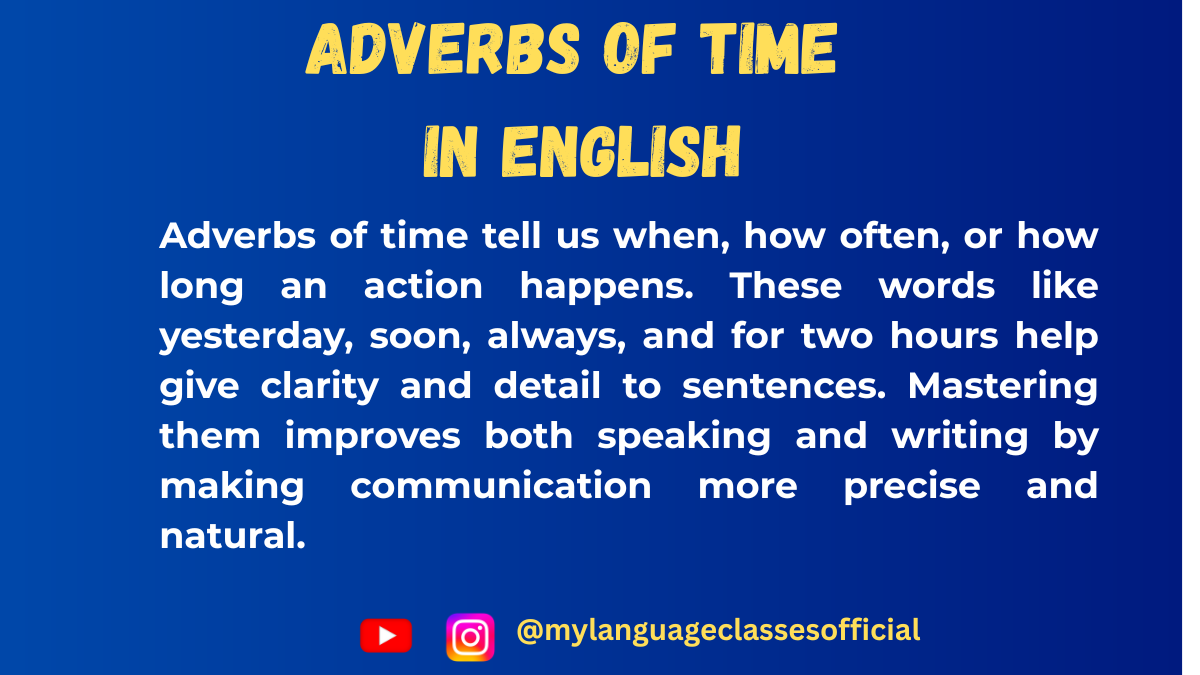
Adverbs of Time in English Grammar
Adverbs of time are an essential part of English grammar, as they help describe when an action takes place. They provide clarity to sentences by indicating past, present, or future time and are commonly used in both spoken and written English.
Understanding adverbs of time is crucial for effective communication, as they allow speakers and writers to express when an event happens, how often it occurs, and for how long. Without these adverbs, sentences can lack important time-related details, leading to confusion.
In this blog post, we will explore common adverbs of time, their grammar rules, different usage scenarios, and example sentences. Additionally, we will provide a practice exercise to help reinforce your understanding of this topic. By the end of this guide, you will have a strong grasp of how to use adverbs of time correctly and naturally in your conversations and writing.
Common Expressions Using Adverbs of Time
Adverbs of time often appear in common everyday expressions that we use in conversations. These expressions help clarify when events occurred, are occurring, or will occur. Below is a list of common expressions and phrases that include adverbs of time:
- At the moment – Refers to the present time.
Example: “I’m busy at the moment.” - In a while – Refers to a short period of time in the future.
Example: “I’ll be there in a while.” - At once – Refers to doing something immediately.
Example: “Please respond at once.” - Every day – Refers to daily frequency.
Example: “I go to the gym every day.” - Right now – Refers to the immediate present.
Example: “I need your help right now.” - Later on – Refers to a time after the present.
Example: “We will discuss this later on.” - Soon after – Refers to something happening shortly after.
Example: “The meeting ended, and soon after, I left.” - At times – Indicates occasional occurrence.
Example: “At times, I feel overwhelmed with work.” - In the past – Refers to a time that has already passed.
Example: “I lived in Canada in the past.” - Once in a while – Indicates infrequent occurrence.
Example: “I treat myself to chocolate once in a while.”
Grammar Rules for Using Adverbs of Time
Adverbs of time have specific grammatical rules that govern their use. Understanding these rules will ensure that you use these adverbs correctly in your sentences.
General Structure
- Position in the Sentence: Adverbs of time generally appear at the end of the sentence, but they can also appear at the beginning or in the middle depending on the emphasis and context.
- Example (end): “She called yesterday.”
- Example (beginning): “Yesterday, she called.”
- Example (middle): “She always calls at night.”
- Use of Articles: Adverbs of time do not require articles, as they modify the verb and indicate the time of the action.
- Plural and Gender: Adverbs of time do not change based on number or gender. They are invariant.
- Types of Adverbs of Time:
- Definite: Refers to specific times (e.g., “now,” “today,” “yesterday”).
- Indefinite: Refers to general time periods (e.g., “soon,” “later,” “soon after”).
Common Adverbs of Time and Example Sentences
Here’s a list of common adverbs of time along with example sentences:
- Now: “She is working now.”
- Soon: “We will leave soon.”
- Yesterday: “I visited the museum yesterday.”
- Today: “The weather is perfect today.”
- Later: “I will call you later.”
- Before: “She had left before I arrived.”
- Afterwards: “We went for coffee afterwards.”
- Always: “I always drink coffee in the morning.”
- Never: “I never go to bed late.”
- Often: “She often goes for a walk in the evening.”
- Frequently: “He frequently travels for work.”
- Seldom: “I seldom watch TV.”
When to Use Adverbs of Time
Adverbs of time are used in various situations to give more information about the time frame of an action. Below are the key situations where adverbs of time are used, along with examples:
1. Present Time
Adverbs of time are commonly used to talk about actions happening now or regularly.
- Example: “She always drinks tea in the morning.”
- Usage: In habitual actions or routines.
2. Past Time
Adverbs of time indicate that an action occurred at a specific time in the past.
- Example: “I visited Paris last summer.”
- Usage: To describe something that happened in the past.
3. Future Time
Adverbs of time are used to express when something will happen in the future.
- Example: “We will meet tomorrow.”
- Usage: To indicate future actions or events.
4. To Indicate Frequency
Adverbs like always, never, and often describe how frequently something happens.
- Example: “I always go for a jog in the evening.”
5. To Specify Duration
Adverbs like for and since specify the length of time for which something happens.
- Example: “She has been waiting since 10 AM.”
6. To Indicate Immediacy
Adverbs like now, immediately, and right away indicate that an action is taking place at this moment or will take place immediately.
- Example: “I need to leave right now.”
Things to Keep in Mind
When using adverbs of time, there are a few things to consider to ensure you don’t make mistakes. Here are some tips and tricky points:
- Placement of Adverbs:
- While adverbs of time usually go at the end of a sentence, they can also go at the beginning for emphasis.
- Incorrect: “She will never forget this.”
- Correct: “She will never forget this.”
- Use of Tenses:
- Pay attention to the tense when using adverbs of time. For example, use yesterday with past tense, and soon with future tense.
- Avoid Overuse:
- Don’t overuse adverbs of time like always, never, and often. Using them too much can make your sentences sound repetitive.
Example Table
Here are some example sentences that demonstrate the use of adverbs of time in different contexts:
Adverb of Time Sentence Now She is eating now. Later I will visit you later. Yesterday He arrived yesterday. Tomorrow We are leaving tomorrow. Soon She will call soon. Never I never go to bed late. Always I always wake up early. Afterward We went to the park afterward. Before He left before I arrived. Sometimes I sometimes skip breakfast. Seldom She seldom eats junk food. Occasionally We meet occasionally. Frequently He travels frequently for work. In the past I lived in London in the past. Once in a while I go to the movies once in a while.
More Example Sentences
- She went for a walk right now.
- I see him frequently at the library.
- Every day, I learn something new.
- We will start the meeting in a few minutes.
- I met her once in Paris.
- I plan to finish my work soon.
- He called me yesterday.
- I will tell you everything later.
- I’m visiting my parents this weekend.
- She always helps me with my homework.
Exercise
Fill in the blanks with the appropriate adverb of time:
- I am going to the gym _______.
- She leaves work _______.
- We will have dinner _______.
- He arrived _______.
- I will call you _______.
- She comes to the office _______.
- The concert will start _______.
- I have not seen him _______.
- They will arrive _______.
- I see my friends _______.
Answers:
- I am going to the gym every day.
- She leaves work early.
- We will have dinner soon.
- He arrived yesterday.
- I will call you later.
- She comes to the office every morning.
- The concert will start in an hour.
- I have not seen him for a long time.
- They will arrive tomorrow.
- I see my friends occasionally.
Conclusion
Mastering adverbs of time is essential for clear and effective communication in English. With the knowledge of how to use these adverbs, when to use them, and the rules governing their usage, you will improve your speaking and writing skills. Be mindful of placement, tense, and the frequency of adverbs to avoid errors. Keep practicing, and soon you will use adverbs of time like a pro!
👉 Visit our blog: mylanguageclassesblog.wordpress.com
👉 Follow on Instagram for daily tips
👉 Subscribe on YouTube for fun grammar videos.Let’s grow your English fluency together—one word at a time!
- At the moment – Refers to the present time.
-
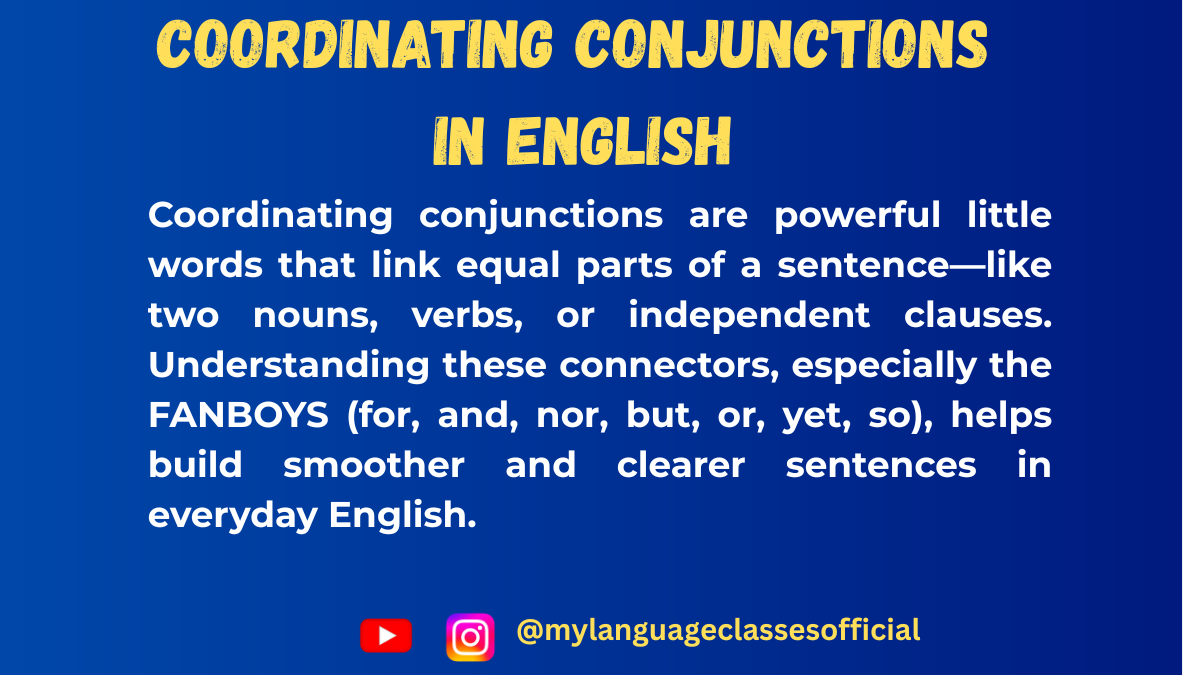
Coordinating Conjunctions in English
Coordinating conjunctions are the glue that holds sentences together. They connect words, phrases, and clauses of equal importance, making your writing and speech more fluid and coherent. Whether you’re a native English speaker or a learner, understanding how to use coordinating conjunctions effectively is essential for clear communication.
In this blog post, we’ll explore the usage of coordinating conjunctions in every possible situation, provide examples, and even test your knowledge with fill-in-the-blank exercises.
What Are Coordinating Conjunctions?
Coordinating conjunctions are words that join two or more elements of equal grammatical rank. The most common coordinating conjunctions are FANBOYS: For, And, Nor, But, Or, Yet, So. These conjunctions are used to connect words, phrases, or independent clauses.
When and How to Use Coordinating Conjunctions
Coordinating conjunctions are used in various situations to connect ideas, show relationships, and create smooth transitions in sentences. Below is a list of situations where each coordinating conjunction is used:
- For:
- Used to indicate reason or cause.
- Example: She stayed home, for she was feeling ill.
- And:
- Used to add information or join similar ideas.
- Example: I love tea, and I enjoy coffee.
- Nor:
- Used to add a negative idea or join two negative clauses.
- Example: He doesn’t like apples, nor does he like pears.
- But:
- Used to show contrast or opposition between ideas.
- Example: I wanted to go, but it started raining.
- Or:
- Used to present alternatives or choices.
- Example: Would you like tea or coffee?
- Yet:
- Used to show contrast or introduce an unexpected result.
- Example: She’s young, yet she’s very wise.
- So:
- Used to indicate a result or consequence.
- Example: It was raining, so we stayed indoors.
List of Coordinating Conjunctions with Examples
Here’s a table of all the coordinating conjunctions along with two example sentences for each:
Conjunction Usage Example 1 Example 2 For Indicates reason or cause She stayed home, for she was feeling ill. He bought flowers, for it was her birthday. And Adds information I love tea, and I enjoy coffee. She sings, and she dances beautifully. Nor Adds a negative idea He doesn’t like apples, nor does he like pears. She didn’t call, nor did she text. But Shows contrast I wanted to go, but it started raining. He’s smart, but he’s lazy. Or Presents alternatives Would you like tea or coffee? You can stay here, or you can leave. Yet Shows contrast or exception She’s young, yet she’s very wise. He’s rich, yet he’s unhappy. So Indicates result or consequence It was raining, so we stayed indoors. She studied hard, so she passed the exam.
More Example Sentences
Here are 10 additional examples to help you understand how coordinating conjunctions work in different contexts:
- I wanted to go to the park, but it was too crowded.
- She didn’t like the movie, nor did her friends.
- You can have cake, or you can have ice cream.
- He’s not only intelligent, but also very kind.
- She was tired, yet she continued working.
- I love pizza, and I love pasta.
- He didn’t study, so he failed the test.
- She bought a new dress, for she had a party to attend.
- They didn’t call, nor did they send a message.
- He’s allergic to cats, yet he adopted one.
Fill-in-the-Blanks Questions
Test your knowledge with these 10 fill-in-the-blank questions. Choose the correct coordinating conjunction from the list: For, And, Nor, But, Or, Yet, So.
- She wanted to go to the beach, _____ it started raining.
- He didn’t like the soup, _____ did he eat the bread.
- You can take the bus, _____ you can walk to the station.
- She was tired, _____ she finished her homework.
- I love reading books, _____ I enjoy watching movies.
- He didn’t study for the test, _____ he failed.
- She bought a new car, _____ her old one broke down.
- He’s not only a great singer, _____ also a talented dancer.
- Would you like tea, _____ would you prefer coffee?
- She’s very busy, _____ she always makes time for her family.
Answers to Fill-in-the-Blanks
- but
- nor
- or
- yet
- and
- so
- for
- but
- or
- yet
Things to Keep in Mind
- Equal Importance: Coordinating conjunctions connect elements of equal grammatical rank (e.g., two nouns, two phrases, or two independent clauses).
- Comma Usage: Use a comma before a coordinating conjunction when joining two independent clauses.
- Example: I wanted to go, but it was too late.
- Avoid Overuse: Don’t overuse coordinating conjunctions, as it can make your writing repetitive.
- Gender Neutrality: Coordinating conjunctions are gender-neutral and can be used in any context.
- Articles: Articles (a, an, the) are not affected by coordinating conjunctions. Use them as needed.
- Example: She bought a book and a pen.
Conclusion
Coordinating conjunctions are a fundamental part of English grammar. They help you connect ideas, present alternatives, and show relationships between words, phrases, and clauses. By mastering the use of FANBOYS, you can improve your writing and speaking skills significantly. Remember to practice regularly and pay attention to the nuances of each conjunction.
If you enjoyed this lesson, be sure to check out more posts like this on my blog at My Language Classes. Don’t forget to subscribe my YouTube channel and follow me on Instagram for the latest language learning tips and lessons. Leave a comment below to share your thoughts, or ask any questions you have about nouns.
Happy learning! 😊
- For:

